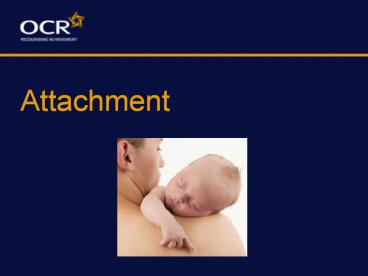Attachment - PowerPoint PPT Presentation
1 / 23
Title: Attachment
1
Attachment
2
What is an attachment?
- An enduring emotional tie with a significant
other e.g. a parent or lover.
3
Why are early attachments important?
- There is evidence that the kind of attachments
you form early in your life affect the kind of
relationships you have later in your life.
4
How do early attachments affect relationships?
- Children that form no attachments (privation) can
grow up have significant problems with
relationships due to poor social and language
skills. - Children who experience deprivation (because they
are separated from an attachment figure) can grow
up to suffer from problems such as depression
(where they withdraw from others) or emotionless
psychopathy (where they show a lack of
consideration of others). - Children who develop and maintain attachments are
more likely to grow up to have productive
relationships.
5
Attachment Types
- Generally, having an attachment is better than
having no attachment at all. - However, there are different types of attachment.
Research suggests that certain types of
attachment lead to better relationships.
6
There are three main types of attachment
- Type A Insecure Avoidant
- Type B Secure
- Type C Insecure Ambivalent
7
What type of attachment are you?
- Type A Insecure Avoidant
- Type B Secure
- Type C Insecure Ambivalent
8
Insecure Avoidant
- When I was younger
- I was quite independent.
- I didnt rely on my parents/carers that much.
- I didnt get that upset about strangers looking
after me. - My parents/carers were not that emotional.
- I didnt tend to tell my parents/carers how I
felt.
9
Secure
- When I was younger
- My parents/carers made me feel safe.
- I had a close relationship with my
parents/carers. - My parents/carers were sensitive to my needs.
- I trusted other people besides my parents/carers.
- My parents/carers seemed to understand where I
was coming from.
10
Insecure Ambivalent
- When I was younger
- I was quite clingy.
- I was quite demanding.
- I was easily distressed.
- I was wary of people who were not that familiar
to me. - I used to play up my parents/carers.
11
How common is each attachment type?
12
Core Study In Attachment
- Hazen Shaver (1987)
- Romantic love conceptualized as an attachment
process.
13
Aim
- Hazen Shaver wanted to show that type of
attachment that a person had in infancy had an
effect on the type of romantic relationships they
would form in the future.
14
Hypothesis
- They predicted that people who had experienced
secure attachments in childhood would have more
secure romantic relationships that those who had
experienced insecure attachments.
15
Method
- They carried out a survey using a questionnaire.
- The questionnaire was printed as a love quiz in
a local American newspaper.
16
Method
- The questionnaire assessed attachment type in
infancy using a checklist. - The questionnaire also measured attitudes to
peoples most important romantic relationship
using multi-choice questions.
17
Method
- 1200 replies to the love quiz questionnaire
were sent in. - Approximately half of these were analysed.
18
Results
19
25
56
19
Results
- Anxious Avoidant
- feared intimacy in romantic relationships
- were jealous of romantic partners
- were more likely to report that they got along ok
by themselves
20
Results
- Secure
- reported friendly, happy romantic relationships
- were more accepting of their romantic partners
- had longer romantic relationships on average and
were less likely to get divorced
21
Results
- Insecure Ambivalent
- more likely to be obsessive in romantic
relationship - experienced extreme attraction but also extreme
jealousy - had shortest romantic relationships on average
and were most likely to get divorced
22
Conclusion
- There is an association between attachment type
in infancy and the nature of romantic
relationships in adult life. - Hazen Shavers theory was that early
relationships with carers provides a mental
template that is then used for future
relationships. This means securely attached
children tend to go on to have more successful
and fulfilling romantic relationships whereas
insecure children tend not to.
23
Evaluation
- The sample was mainly females and all were
self-selecting respondentsso findings may not
generalise to the rest of the population. - Respondents were only asked about their most
important romantic relationshipsso it may not
be representative of others. - Relationships were assessed through closed
questionswhich may have been too simple for
something so complex. - Respondents were required to recall features of
their attachment in childhoodbut because its
retrospective it may be unreliable. - The questions were quite personalso respondents
may have been tempted to lie (especially as they
were not traceable) leading to invalid results.































